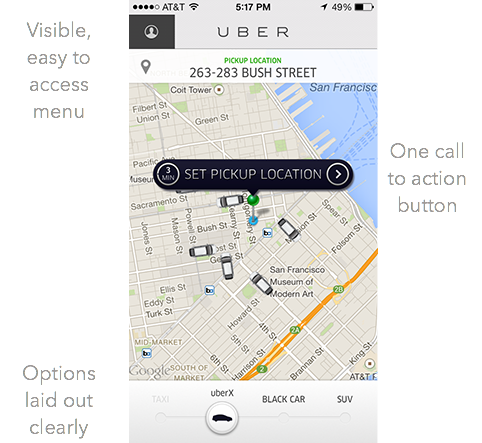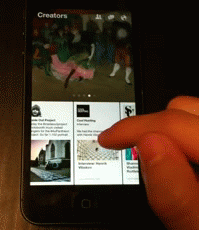Two Types of Mobile Apps
There are two types of mobile apps in the world: "utility apps" and "leisure apps". It might sound like I'm oversimplifying, but I think determining which category your app falls into is a big first step to deciding how you want to organize the interface.
Utility apps are designed with a user-specific end goal in mind. Once this end goal is met, there really isn't much of a reason for the user to spend time on the app. Let's take Uber for example. The user-specific end goal for Uber is to call a cab and make a payment, all from your mobile device. Once you've called your cab, that's it, nothing else is needed from the app. Its simple design is what makes it intuitive and undaunting for new users.
Design for utility apps should be idiot-proof, have only *one* call to action button, and should follow a single line of thought that will take you to the end goal. This doesn't mean that neat animations or quirks can't be used - that's what makes the experience unique! But it does mean that learned behaviors should be kept to a minimum. A learned behavior is when the user has to go through trial-and-error or a tutorial to figure out where/how to swipe to make something happen. Instead of relying on learned behaviors to navigate through the app, visible menus and navigation bars with clear choices are preferable.

Uber. A utility app.
In contrast, leisure apps are apps that don't have a narrowly defined end goal in mind for the user. Usually words like "explore" and "discover" are used in these apps' taglines. These apps are meant to be explored, with neat learned behaviors to help trigger different parts of the app. An example that comes to mind is Paper. Paper is a delightful app to use, where swiping in different directions on the screen yields new content and corresponding animations.

Paper. That experience.
Design for leisure apps should truly create an experience that the user can delve into. Nifty, hidden tricks encourage discovery and add to the novelty of the app. Over time, users develop habits and feel at home because they've learned the ins and outs of the app. It's like when you discover the secret exit in Super Mario and are rewarded with a room full of gold coins. Or when you finally stop dying at the first pipe in Flappy Bird. That feeling. That feeling of excitement from uncovering a new trick by yourself. Of mastering the unknown. That's how you want your users to feel.
So that's what it boils down to for me: utility or leisure?